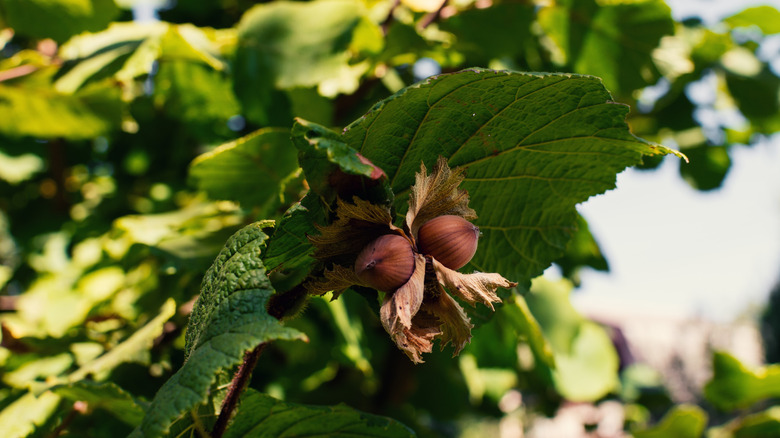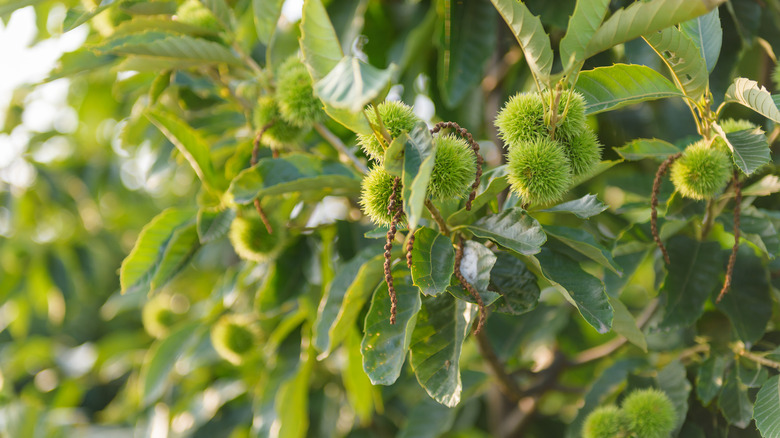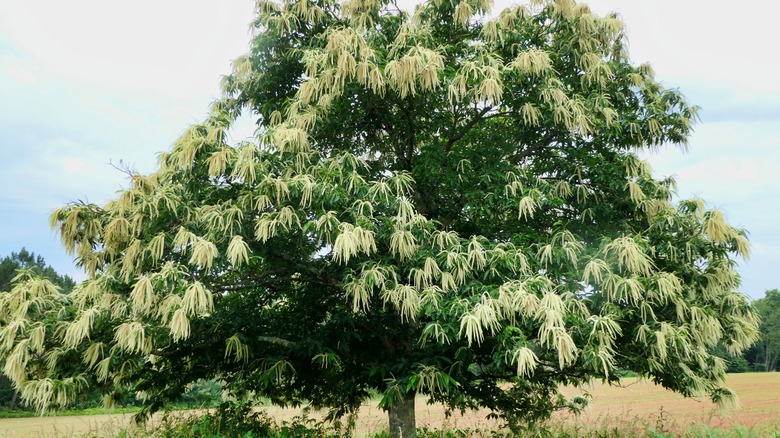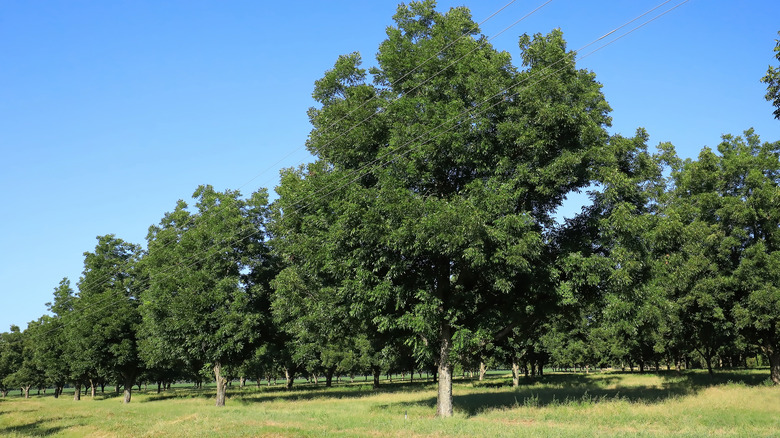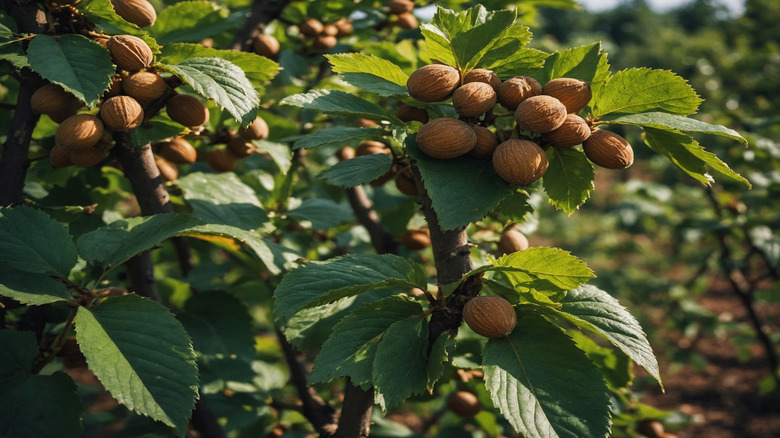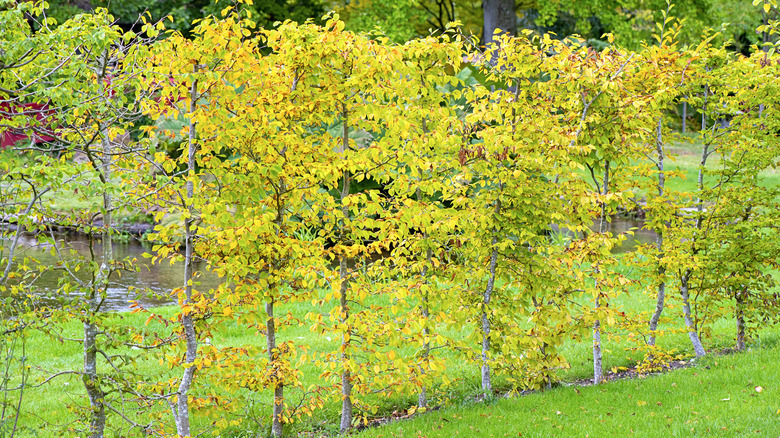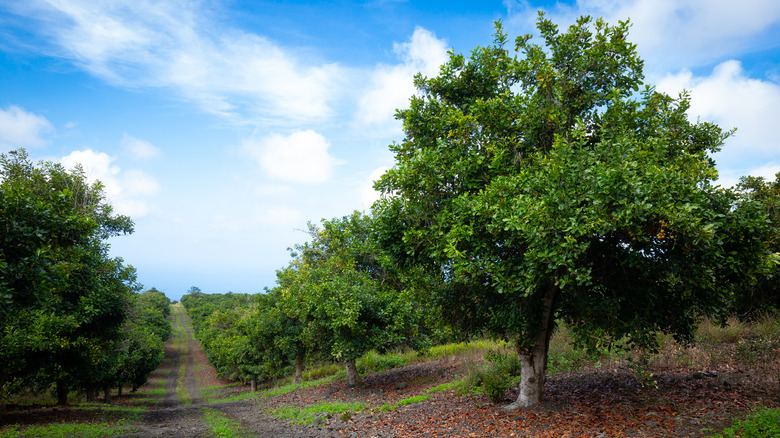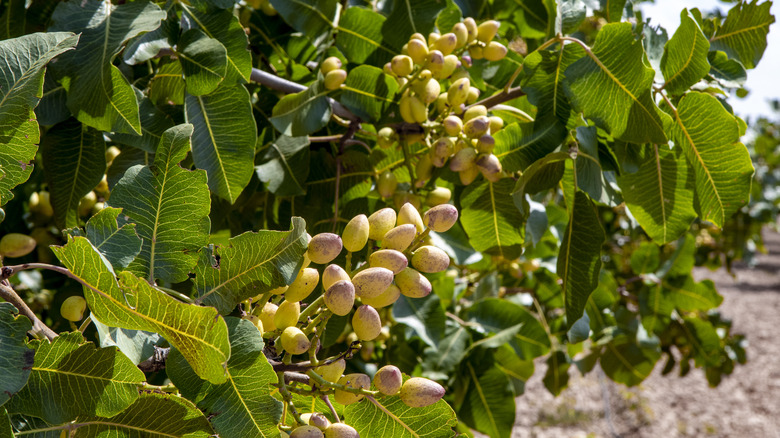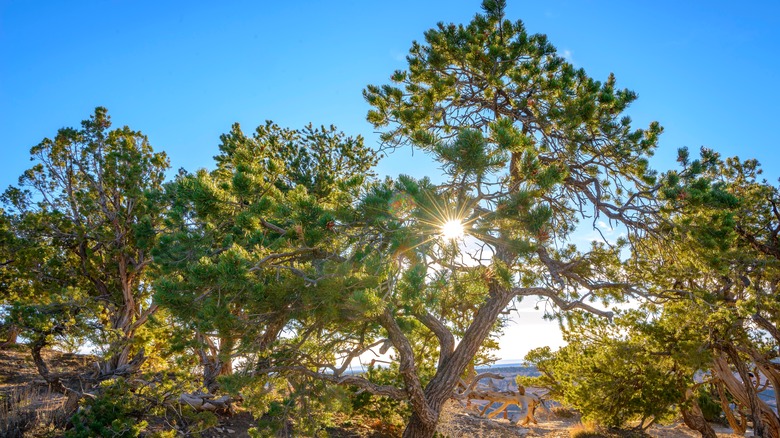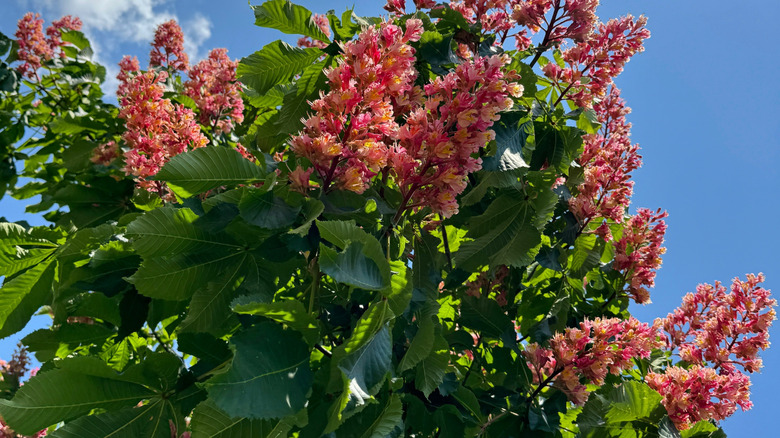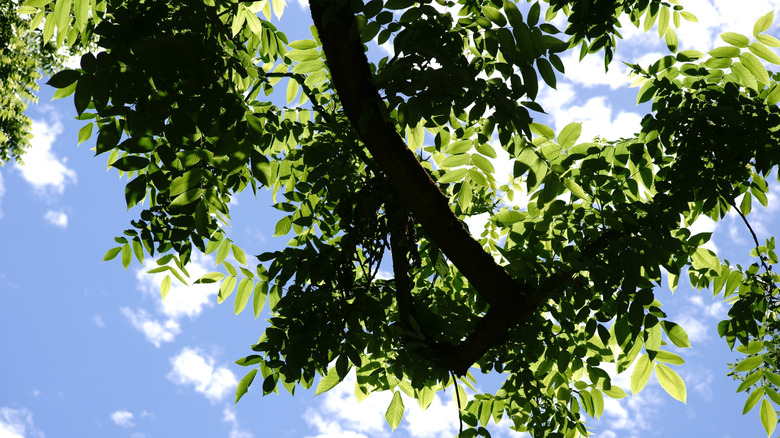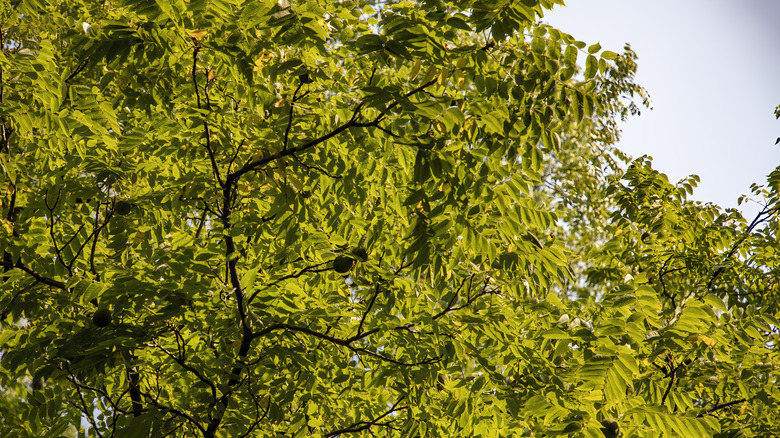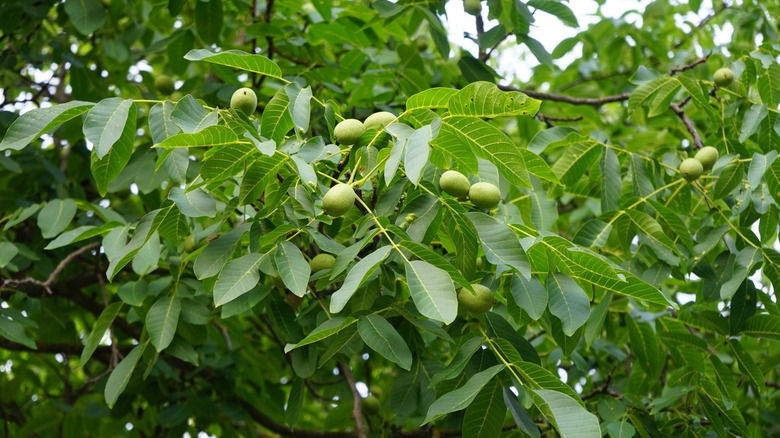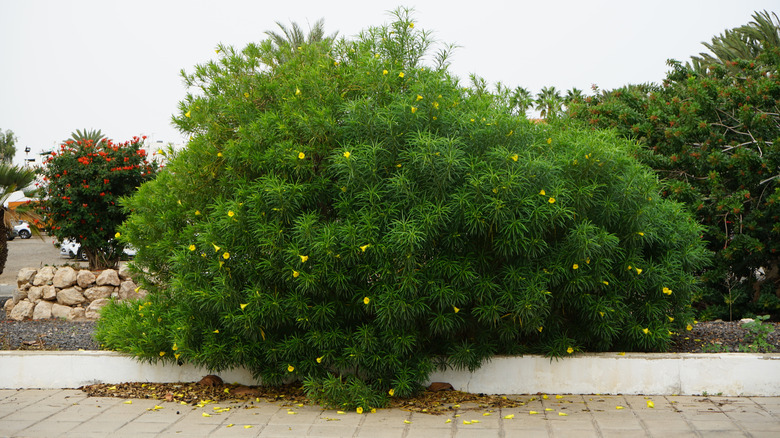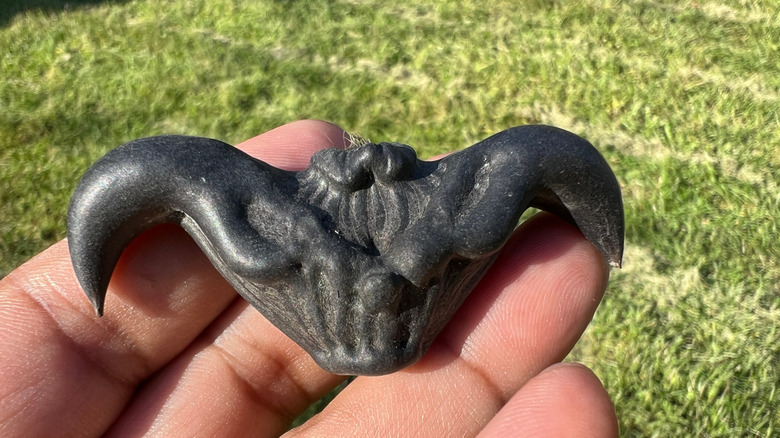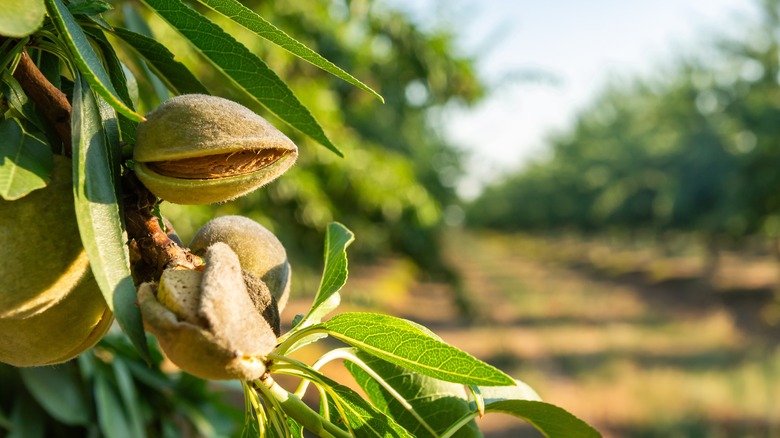The Best Nut Trees To Grow In Your Yard (And Which Ones To Avoid)
We may receive a commission on purchases made from links.
If you're planning a landscape refresh this year, why not add a little bit of deliciousness by planting a few nut trees? Not only will your new tree be an excellent source of shade and look great, but you'll also get free nuts every harvest — so what's not to love? Well, okay, there are a few things we can think of that might go wrong, especially if you pick the wrong type of nut tree to grow.
That's why we're breaking down the best nut trees for homeowners to cultivate in their yards (and which to avoid). We'll cover the nine easiest nut trees to grow, explaining their growing requirements and why they're such a good fit for your yard. Plus, we'll also dive into a few tree species that you might want to think hard about before planting, as well as name four trees that we believe are absolute "no-nos" to grow. So grab your Amex, and let's go tree shopping.
Yes: Chinese chestnut (Castanea mollissima)
Chinese chestnuts (Castanea mollissima) can grow to around 40 feet wide and tall, and look absolutely stunning during the fall when their leaves change to a burnt orange hue. They're also one of the few chestnut trees resistant to chestnut blight, a particularly lethal tree disease that's all but wiped out the American version of this species. Because of their manageable height, disease-resistance, and ample shade spread that's perfect for outdoor seating, they're a great tree to grow on your property, no matter your skill level. However, be aware that some Departments of Agriculture still have strict regulations for chestnuts. Oregon, for example, does not allow the import of chestnut trees from the East Coast, so plan your tree sourcing accordingly.
Chinese chestnut trees need full sun, but can tolerate partial shade if that's all you've got. This tree isn't too picky about its soil conditions and can thrive in loam, sand, or even poor nutrient soils. Your Chinese chestnut tree should begin producing nuts in the fall after it's settled in. That said, if you've got the room, planting more than one lets them cross-pollinate and produce more nuts every year. Just watch where you walk, as stepping on a fallen chestnut is nature's equivalent to stepping on a LEGO.
Yes: European chestnut (Castanea sativa)
Say hello to the European chestnut (Castanea sativa) — a massive tree, maxing out at around 90 feet high with trunks that are 7 feet in diameter. These trees have a striking appearance with large, glossy leaves that turn yellow during the fall. This can make them a great centerpiece if you have a spacious yard, adding a visually appealing boost to your landscaping. They're also a great choice if you're trying to fill holes in your large yard, and quickly. These trees grow relatively quickly compared to other hardwoods, sprouting up to 3 feet in one year while young. And since they grow 30 to 50 feet wide, they will take up plenty of open space and give you a nice, shady spot to set up chairs and tables.
However, this species of chestnut is susceptible to chestnut blight, so it may be hard to find in the U.S. But if you stumble on a sapling and want to give it a shot, plant it in well-draining soil that's slightly acidic. Like its Chinese cousin, the European chestnut loves full sun and becomes a tough, hardy tree that's drought-resistant. It can even live along coastal landscapes where ocean salt spray is often a death sentence to more delicate plants.
Yes: Pecan tree (Carya illinoinensis)
We'll admit it: The reason we've held off planting our own pecan tree (Carya illinoinensis) is only because we'd do nothing but make pecan pies. Pecan trees are amazing, and we'll happily live vicariously through your planting. Plus, pecans are native to the U.S. and Mexico, so they're already acclimated to our climates and soils, making them one of the easiest nut trees to grow. This makes them a perfect pick for newbie gardeners looking to spruce up their yard. However, one (literally) massive mistake people make when growing pecan trees is not realizing these trees can reach up to 130 feet tall, so make sure you have enough space first. If you're space-limited, but still want a pecan tree, consider the 'Cape Fear' or 'Chickasaw' varieties, which top out at around 40 to 60 feet, or learn how to prune your trees to keep them smaller.
Growing pecan trees takes a little bit of botany to ensure a good nut production. Pecan trees have separate male and female flowers on each tree (known as "monoecious") and have alternating pollen schedules, so you'll need at least one tree from each "type." Type I pecan trees release pollen before the female flowers are ready, while Type II release pollen after. It's a frustrating game of courtship, but the North Carolina University State Extension breaks down which pecan species falls into which type. However, if you're new to planting and just want an aesthetic tree without the bountiful nut production, then you can skip this step.
Yes: Hazelnut tree (Corylus americana)
Hazelnut trees (Corylus avellana) aren't very big, usually topping out around 15 feet in height, making them an awesome option for small gardens. They're also a great contender if you're looking for an aesthetic way to add privacy to your yard. If you don't prune them, they will grow 15 feet wide, creating a hedgerow full of hazelnuts just waiting to be turned into a Nutella-esque spread.
Speaking of hazelnut spreads, make sure you get the right cultivar, as some of the other versions (C. americana or C. colurna) nuts don't have the same taste as C. avellana. Hazelnut trees like full sun, but do best in climates that have a distinct winter season, as they need a dormancy period. They produce male and female flowers that bloom in late winter, but won't produce nuts until late summer. Plant your hazelnut tree in soil that has good drainage, is consistently moist, and has a neutral or slightly alkaline pH.
Yes: American beech (Fagus grandifolia)
The American beech (Fagus grandifolia) can grow up to 80 feet tall with lots of low branches that make it perfect for curious climbers, making it a great addition for family yards. It's also a great pick for gardeners with large gardens looking to add variety to their landscaping. Its smooth, silvery bark stands out and adds a unique visual element to your design, especially during the winter months when everything else is brown. This is also a great tree to plant if you love bird watching, since all sorts of birds flock to it to both nest and eat. For instance, the buds and flowers are eaten by birds like purple finches and rose-breasted grosbeaks, while songbirds like the black-throated blue warbler build nests in the beech's branches.
American beech trees need big spaces to thrive and make it hard for ground covers, grass, or other plants to live under its heavy shade, so save this for homes with lots of acreage. This tree needs acidic, consistently-moist, but never waterlogged. Thanks to its imposing mature size, American beech trees can tolerate partial shade easier than others, but would still prefer full sun. Also, learn how to protect your beech trees from beech leaf disease (BLD), a disease spread by nematodes that can kill your beech if left untreated.
Yes: Macadamia tree (Macadamia integrifolia)
Macadamia nut trees (Macadamia integrifolia) will reach up to 50 feet high when in-ground and are a great pick if you're looking to add color to your yard. They bloom clusters of pink flowers that smell heavenly. They're also one of the few trees that thrive in containers, which is useful for cooler climates or smaller yards. While it takes around six to seven years for the first nuts to form, the payoff is worth the wait.
Macadamia nut trees can start off finicky, but will mellow out as they age. When first planted, they'll need lots of water, so plant it somewhere with consistently moist, fertile soil. If planting it in a container, you may want to add a drip irrigation system, like the TRJZWA Solar Automatic Drip Irrigation System Kit, to keep it happy. Once they're established, you can back off the water routine; macadamia nut trees become tough, drought-resistant trees once they acclimate.
Yes: Pistachio (Pistacia vera)
There are some trees that are so finicky they almost need a full-time staff to care for them. Pistachio (Pistacia vera) is not one of them. It's a tough, hardy tree that's easygoing and relatively pest-free. Pistachio trees will top out around 30 feet tall, making them perfect for smaller yards. They are also both drought and salt tolerant, making them a viable pick for gardens in drier regions or homes by the ocean. Like most nut and fruit trees, it will begin producing nuts as early as five years after being established. However, full pistachio production won't start until around year 15 or so. While you might have to wait over a decade to have a bountiful harvest, this is a great tree for yards that are looking for something long-lasting (and that won't require removal after 50 or so years.) It can live up to 300 years, ensuring it will be in your garden for generations to come.
Pistachio trees grow best in climates that have at least six weeks of temperatures below 45 degrees Fahrenheit and three-and-a-half weeks above 85 degrees Fahrenheit. However, some experts believe it needs longer summers and mild winters, so we recommend giving it a shot if you live somewhere that has seasonal changes. Pistachios need full sun and well-draining soil; otherwise, it's not fussy about pH levels or soil conditions.
Yes: Pinyon pine (Pinus edulis)
Pinyon pine (Pinus edulis) is a native tree to the Southwestern U.S. that produces pine nuts, or pinyons, after only two years post-establishment. It's one of the shorter and slower growing pines, taking around a decade to reach up to only around 20 feet tall, making it a great pick for smaller gardens. Also, it is one of the few from the Pinus genus that does exceptionally well in hot, dry climates. So, if you're looking for a good tree for your rock garden or xeriscape, this might be the tree for you.
Pinyon pines are drought-tolerant thanks to their native climates, and will absolutely freak out if they're planted somewhere that has consistently-moist soil, so aim for well-draining, rocky soil and full sun. That said, we feel it's important to point out that all of that dry bark and needles can pose a fire hazard, so don't plant it too closely to your home and be mindful of the fallen needles.
Maybe: Red buckeye (Aesculus pavia)
Now, let's dive into the trees that have considerable pros and cons you'll need to weigh. First off is the red buckeye (Aesculus pavia), a small tree that's native to a long span of the Eastern U.S. and has gorgeous reddish-pink blooms that give it the nickname "firecracker plant." This makes it a great pick for gardeners looking to add color and interest to their landscaping. The red buckeye will only grow to around 25 feet high, making it great for smaller yards, and is a big attractor of hummingbirds and butterflies. Its nut, the buckeye, isn't edible for humans, but wildlife loves them. This makes it an attractive pick for people who love bird- and deer-watching in their backyards. Since it has such a varied native habitat, it's also fairly easygoing, well-behaved, and isn't picky about pH levels or soil types.
So, what's the problem? Well, the red buckeye contains glycoside aesculin and saponin aescin throughout its bark, seeds, leaves, and stems. These two chemicals are extremely poisonous to humans and horses, so if you've got curious kiddos who explore by putting things in their mouths or if you own horses, this isn't the tree for you. If you're in the clear, then the red buckeye will need consistently moist soil and partial shade to thrive.
Maybe: Butternut tree (Juglans cinerea)
Butternut trees (Julgans cinerea) are members of the walnut family and have the most delicious nuts that both humans and critters love. Butternuts are great trees due to their cold-hardy nature and medium-ish lifespan of around 75 years. They'll stay relatively small compared to their walnut cousins, maxing out around 60 feet square, making it a more manageable addition to your yard. In some parts of the U.S., the butternut is considered endangered, so adding this to your yard would help boost its numbers.
The downsides to the butternut are two-fold. First, it's highly susceptible to butternut canker disease, a significant contributing factor to its endangered designation. Second, its roots produce the chemical juglone, which can inhibit the growth or outright kill certain plants within an 80-foot radius of its trunk. Acid-loving plants like azaleas, rhododendrons, tomatoes, and peonies are especially susceptible. If you do decide to go for it, plant your butternut in moist, well-draining soil and make sure it has full sun. This tree is a little bit of a prima donna and doesn't appreciate living in the shade or having neighbors who will compete for its resources, hence the juglone.
Maybe: Black walnut (Juglans nigra)
The black walnut tree (Juglans nigra) is, in our opinion, a show-stopper. It's a massive tree that can grow up to 90 feet and has gorgeous, deeply-colored bark. Plus, its walnuts are highly sought-after and can command a pretty penny at the farmer's market.
If you didn't notice, its scientific name gives away the reason it's on the "maybe" list: Juglans, the genus of juglone-producing plants that inhibit competitors from growing near it. Since this tree is so big and formidable, you'd have to give it a really wide berth to keep the juglone at bay, or plant juglone-resistant plants around it.
Finally, walnuts need a ton of water for nut production, around 5 gallons per walnut. So, if you're in an area that's prone to droughts, this could be problematic. If you decide to go for it, plant your black walnut tree in an area with full sun and consistently-moist soil that's well-draining, full of organic matter, and slightly acidic.
Skip: English walnut (Juglans regia)
Now let's dive into the trees where the cons more than outweigh the pros, starting with the English walnut (Juglans regia). Not only are they juglone-producing trees, but they're even more high maintenance than the butternut and black walnut. J. regia is intolerant of shade and soils with low nutrients or those consistently wet. It also wilts in climates that are hot and humid, so it needs a very Goldilocks-style zone of comfort to thrive.
Finally, if its care requirements aren't frustrating enough, the English walnut is susceptible to a host of problems, including blight and husk fly infestations. Some English walnuts begin as grafted plants to black walnuts and can develop a problem known as "blackline." Blackline is a compatibility issue between grafted plants that causes nutrient deficiencies in the graftee, which shortens its lifespan. While black walnut trees live an average of 250 years, an English walnut tree with blackline may die after only 15 to 25 years.
Skip: Lucky nut (Cascabela thevetia)
While its cheerful yellow flowers might make it seem like a happy little tree to plant, the lucky nut tree (Cascabela thevetia) is anything but lucky. A hint as to why could be in one of its nicknames: yellow oleander. If you're unfamiliar, oleander plants (Nerium oleander) are fatally toxic to humans, and the lucky nut is no different — even though it's from a different genus.
Lucky nut trees contain cardiac glycosides, which affect the cardiac system. Even the smoke from a burning lucky nut tree can be toxic and require immediate medical attention, making it particularly hazardous in areas that are prone to wildfires. Therefore, in our opinion, it's simply not worth growing in your yard.
Skip: Buffalo nut (Pyrularia pubera)
We're sad to see this one on the naughty list because its nuts look so goth and cool. But the buffalo nut tree (Pyrularia pubera), which is most commonly found in the Appalachian Mountain region, and its devlish-looking nuts contain an acrid oil that's poisonous to humans. The oil has pyrularia thionin, a peptide that's like snake venom, with cytotoxic, neurotoxic, and hemolytic properties.
Researchers also believe the oil might contain calcium oxalate, the same chemical that makes the dieffenbachia houseplant so deadly. So, sorry, little death metal tree, but we'll have to admire you from afar.
Skip: Almond tree (Prunus spp.)
Don't get us wrong, almonds and their trees (Prunus spp.) have a lot going for them. One variety, Prunus dulcis, can get up to 25 feet tall, so they're still a manageable size for most hobbyist farmers, and its almonds are tasty. Another, Prunus glandulosa, is famous for its soft pink flowers and is relatively drought-tolerant. But the Prunus family is a finicky set of trees that all require more maintenance than you might expect.
First, almond trees are susceptible to a whole collection of pests, such as spider mites, stink bugs, scale, borers, and fire ants. Next, they're prone to water-related stress; if they don't get enough water, their nut production will falter. Unfortunately, almond trees need a lot of water — about 1 gallon per almond — and in places with heavy droughts, this can become a big problem. To put it in perspective, the California Department of Water Resources estimates it takes a little over 1 billion cubic meters of water to service all homes and businesses in the city of Los Angeles and 3.5 billion cubic meters of water to maintain the state's almond orchards. Lastly, those pretty pink almond flower trees, P. glandulosa, produce poisonous cyanide in their leaves, stems, and seeds.
